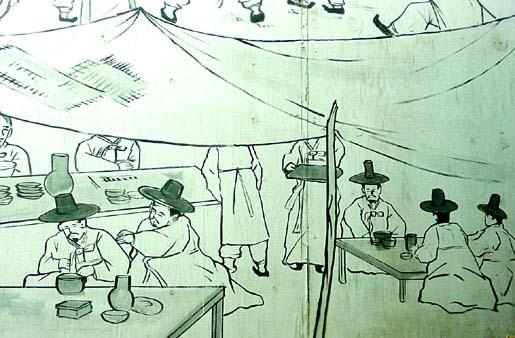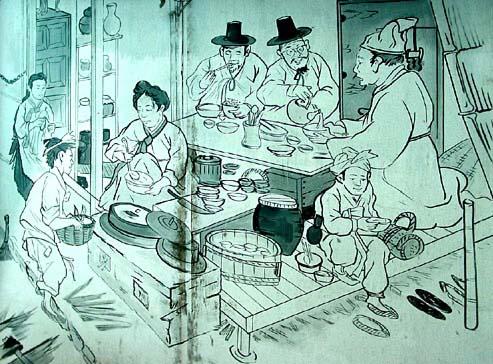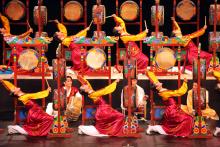Primary tabs
Enjoy Makgeolli, Korea's Oldest Alcoholic Beverage
Likes: 0

Although most foreigners in Korea have heard of soju, Korea's most popular alcohol today, makgeolli was previously Korea's most popular. Dating back 2,000 years, makgeolli is Korea’s oldest alcoholic beverage. The name of makgeolli reflects well on how it is made- it is a compound of mak (recklessly or carelessly) and the noun derived from the verb stem georeu (to strain or to filter). It is very simple to make- just toss the ingredients together, then strain out most of the solids after about a week of fermenting. And the basic recipe requires just 3 ingredients to make: water, rice, and nuruk (a dry cake compound of yeasts, bacteria, and koji mold spores).


Another name for makgeolli is nongju (for "farmer's wine"; ju means alcohol in Korean), which reflects its simplicity and traditional popularity among farmers and other commoners in the countryside. In fact, many families made their own batches, especially as it was needed for ancestral memorial rites as Confucianism developed. (Even today, many Koreans still use makgeolli for this purpose.)


In the olden days, most taverns (jumak in Korean) would have a large vat of makgeolli available for patrons. The proprietor would just ladle some into a clay pot and put on the table for patrons. Individuals at the table would then pour (or ladle) from that pot into individual bowls without much formality. This casualness, reinforced by the alcohol's name, helped grow makgeolli's identity as a casual, simple, and common drink.
 With its abundance and casual nature, makgeolli became the most-consumed alcoholic drink in South Korea during the 1960s and 1970s. However, it started losing its popularity in the 1970s and 1980s with the rise of processed Korean alcohols and imported alcoholic drinks. By the late 1980s, soju had become more popular, with makgeolli all but disappearing from most modern drinking establishments.
With its abundance and casual nature, makgeolli became the most-consumed alcoholic drink in South Korea during the 1960s and 1970s. However, it started losing its popularity in the 1970s and 1980s with the rise of processed Korean alcohols and imported alcoholic drinks. By the late 1980s, soju had become more popular, with makgeolli all but disappearing from most modern drinking establishments.
Starting from the late 1990s, as Koreans became more health conscious and started looking for alternatives to the rigid drinking culture, makgeolli started gaining in popularity again. New types of drinking establishments have opened specifically catering to makgeolli drinkers with a more casual and traditional environment.

Healthy Drinking
Here’s a great excuse to drink makgeolli- the microorganisms present during fermentation make it a probiotic product. High levels of lactic acid bacteria, as well as vitamins, amino acids, and fiber make it very good for your digestion. Additionally, with a 1.9 percent protein content, more than 10 amino acids, vitamin B, inositol, and choline, makgeolli has a reputation for increasing metabolism, improving complexion, and even relieving fatigue. The health benefits have helped give it a renewed popularity in urban areas and among younger people.

How to Drink Makgeolli
Makgeolli is best consumed fresh (within 1-2 weeks after brewing) when it has a milder and creamier taste. With an alcohol content between 6-7%, it’s similar to enjoying a beer or a glass of wine. Since it isn’t really considered heavy drinking, it has become increasingly popular among young women. (But as a good drink knows no gender, men can enjoy it as well without embarrassment). You can sip makgeolli throughout the evening and maintain a nice buzz without getting a bad hangover the next morning.

Makgeolli is generally served cold, from a pottery bowl with a ladle or a traditional jug. Prior to drinking, the liquid is stirred with the ladle (or if serving directly from the bottle, it is gently flipped upside down several times with the cap on) in order to mix the settled sediment. When it comes time to drink, it is then ladled (or poured) into individual small bowls, rather than cups, which emphasizes the traditional nature of the drink. Drinking makgeolli from a modern glass just doesn’t seem right!
Also, if you like makgeolli, do not forget its cousin dongdongju. The less-popular (but still delicious) variation, is an unfiltered “cousin,” and a typical cup of dongdongju may have some rice particles at the bottom, giving it an interesting texture. Besides the variance in thickness and texture from the different filtering, dongdongju has a very similar flavor to makgeolli. So if you’re a fan, give dongdongju a try and compare for yourself.
There are also several types of food that Koreans usually eat while drinking magkeolli- please see Enjoy Some Food with Your Korean Drinks! for more details.

Enjoy Makgeolli First-hand
If you would like to experience makgeolli in an authentic setting, Stunning Korea can help arrange it. We can even arrange a class where you can learn to learn how to make it yourself! Request a Custom Tour! Share your experiences and opinions about makgeolli and dongdongju in the Comments section below.


Another name for makgeolli is nongju (for "farmer's wine"; ju means alcohol in Korean), which reflects its simplicity and traditional popularity among farmers and other commoners in the countryside. In fact, many families made their own batches, especially as it was needed for ancestral memorial rites as Confucianism developed. (Even today, many Koreans still use makgeolli for this purpose.)



Starting from the late 1990s, as Koreans became more health conscious and started looking for alternatives to the rigid drinking culture, makgeolli started gaining in popularity again. New types of drinking establishments have opened specifically catering to makgeolli drinkers with a more casual and traditional environment.

Healthy Drinking
Here’s a great excuse to drink makgeolli- the microorganisms present during fermentation make it a probiotic product. High levels of lactic acid bacteria, as well as vitamins, amino acids, and fiber make it very good for your digestion. Additionally, with a 1.9 percent protein content, more than 10 amino acids, vitamin B, inositol, and choline, makgeolli has a reputation for increasing metabolism, improving complexion, and even relieving fatigue. The health benefits have helped give it a renewed popularity in urban areas and among younger people.

How to Drink Makgeolli
Makgeolli is best consumed fresh (within 1-2 weeks after brewing) when it has a milder and creamier taste. With an alcohol content between 6-7%, it’s similar to enjoying a beer or a glass of wine. Since it isn’t really considered heavy drinking, it has become increasingly popular among young women. (But as a good drink knows no gender, men can enjoy it as well without embarrassment). You can sip makgeolli throughout the evening and maintain a nice buzz without getting a bad hangover the next morning.

Makgeolli is generally served cold, from a pottery bowl with a ladle or a traditional jug. Prior to drinking, the liquid is stirred with the ladle (or if serving directly from the bottle, it is gently flipped upside down several times with the cap on) in order to mix the settled sediment. When it comes time to drink, it is then ladled (or poured) into individual small bowls, rather than cups, which emphasizes the traditional nature of the drink. Drinking makgeolli from a modern glass just doesn’t seem right!
Also, if you like makgeolli, do not forget its cousin dongdongju. The less-popular (but still delicious) variation, is an unfiltered “cousin,” and a typical cup of dongdongju may have some rice particles at the bottom, giving it an interesting texture. Besides the variance in thickness and texture from the different filtering, dongdongju has a very similar flavor to makgeolli. So if you’re a fan, give dongdongju a try and compare for yourself.
There are also several types of food that Koreans usually eat while drinking magkeolli- please see Enjoy Some Food with Your Korean Drinks! for more details.

Enjoy Makgeolli First-hand
If you would like to experience makgeolli in an authentic setting, Stunning Korea can help arrange it. We can even arrange a class where you can learn to learn how to make it yourself! Request a Custom Tour! Share your experiences and opinions about makgeolli and dongdongju in the Comments section below.
You must join this group to see the full content or post comments.
 Forward
Forward Twitter
Twitter Google+
Google+ LinkedIn
LinkedIn
